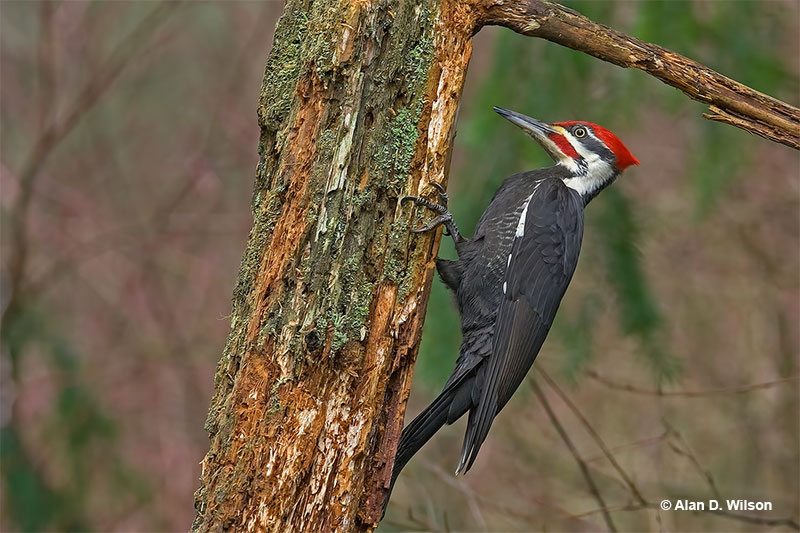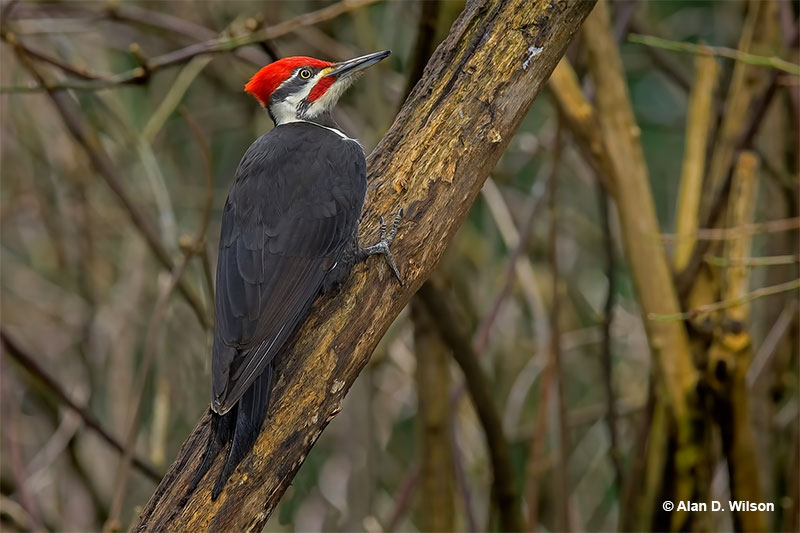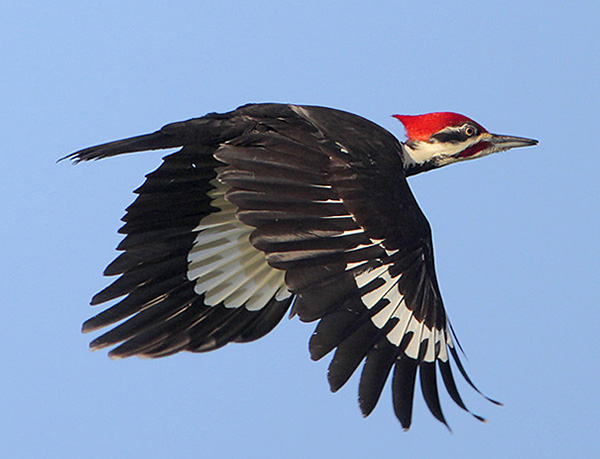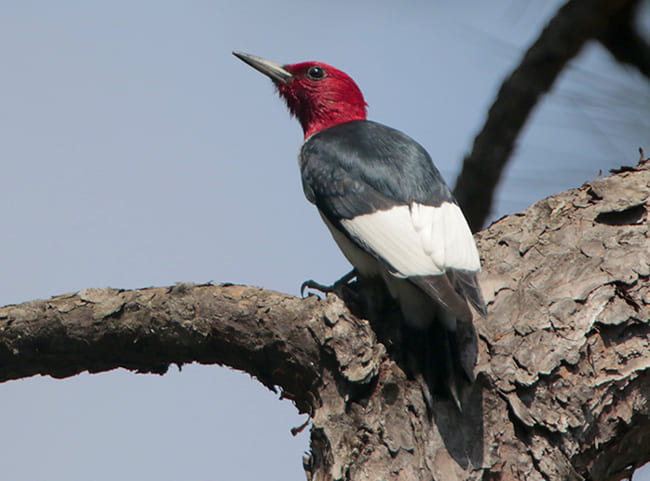The Pileated Woodpecker is a very large woodpecker. In fact, it is the largest woodpecker in North America.
They have long necks, long, chisel-like bills, and a triangular crest on the backs of their heads. In flight, the wings are wide and look crowlike. These birds are uncommon since they prefer to stay deep in the wood and are very secretive about their nesting sites.
You’ll find Pileated Woodpeckers drumming away at fallen logs and dead trees in search of prey. They leave behind rectangular holes, unlike other woodpeckers who leave round holes.
Once these birds leave their nesting holes, other animals like owls, swifts, bats, pine martens, and ducks will take over for shelter.
See the short web story here:
On this page
Identification
Pileated Woodpeckers are very large woodpeckers. They’re mostly black, have white stripes on the neck and face, and have a bright red crest. Additionally, they have a red line on the cheek. When these birds fly, we can see that they have white on the underside of their wings and small white crescents on the bases of the primaries and the upper side.

© Alan D. Wilson
Female Pileated Woodpeckers look pretty similar, but there are some minor differences.
Both male and female Pileated Woodpeckers have red crowns, but the males’ red color on the crest extends all the way down to their bills.
The red coloring on the females stops on the top of the head. The forecrown is instead gray or black instead of red. We would like to mention that it’s not uncommon to see minor variations in this woodpecker species.
Food
The Pileated Woodpecker’s diet can vary quite a bit. However, these birds prefer to consume carpenter ants. If their diet is mainly carpenter ants, they’ll supplement with other types of ants, woodboring beetle larvae, flies, termites, spruce budworms, grasshoppers, cockroaches, and caterpillars.
Related: Why do woodpeckers peck wood?
Their diet involves more than just insects; they’ve also been known to eat wild nuts and fruits like greenbrier, sassafras, hackberry, sumac berries, blackberries, poison ivy, dogwood, holly, elderberry, and persimmon. In some studies that revolved around the Pileated Woodpecker diet, it was found that, on average, 40 percent of their diet is ants, and for some birds, 97 percent of their diet is ants.
You may even see Pileated Woodpeckers at your backyard bird feeders if you’re lucky enough. They have been seen consuming suet and fruit and nut birdseed.
Nesting and Eggs
Pileated Woodpeckers prefer to nest in dead trees, but they have been seen nesting in old deciduous and coniferous forest trees. They’re also not afraid to nest in dead trees in younger forests and even cities. Dead trees are a valuable resource to not only these birds but other species and birds and mammals.
Some use them for nesting cavities, while others just use them for shelter. Pileated Woodpeckers battle for ownership of these trees with European Starlings, Wood Ducks, Red-bellied Woodpeckers, Eastern Bluebirds, Great Crested Flycatchers, and Red-headed Woodpeckers. Occasionally swifts and bats will share the cavities with Pileated Woodpeckers.

The male Pileated Woodpecker is the one to start the excavation process. The female Pileated Woodpecker does usually help when the cavity is near completion, but the male does a lot of the excavating. The entry hole is not circular; it’s more of an oblong shape. This is uncommon for a woodpecker species because nesting holes are usually round.
Related: Bird Quotes To Make Your Day Brighter
To finish up the nesting cavity, one of the birds in a mated pair will climb into the hole and chip the inside. On occasion, the adult will pick up chips they cleared from the inside with its bill and toss them out of the entrance.
Pileated Woodpeckers don’t use any material to line their nests. If they do use anything, it’ll be any leftover wood chips. Creation usually takes 3 to 6 weeks, and nests are hardly ever reused. Cavity depth can range from 10 to 24 inches.
These birds lay anywhere from three to five eggs. Pileated Woodpeckers only breed once per breeding season. After laying the eggs, they incubate for 15-18 days, after which the baby woodpeckers hatch. Young birds stay in the nest for around a month.
Current Situation
Pileated Woodpeckers populations have been steadily increasing since the late 1960s. They’re still a relatively uncommon bird to see because they prefer to stay rather deep in the forest.
However, their population is healthy. It is estimated that their global breeding population is around 2.6 million. They’re rated 7 out of 20 on the Continental Concern Score, meaning they’re a low concern species.
Related: Types of Woodpeckers in North America
Historically, their population has decreased due to the clearing of forests. However, there is still a risk of population decline due to them relying on fallen logs and standing, large dead trees. These things are often cleared out because property managers consider them to be undesirable.
It’s important that these birds have access to these elements because not only do they provide access to food, but they also provide nesting and shelter for the many species of birds and mammals, including the Pileated Woodpecker.

Photograph © Greg Lavaty.
Facts
- Pileated Woodpeckers specifically dig rectangular holes in trees to find prey. This is special to them because other woodpeckers dig round holes. Additionally, these excavations are known to cause small trees to break in half because of how wide and deep they make their holes.
- Pileated Woodpecker excavations are so large that other birds are often attracted to them. For example, House Wrens and other woodpeckers may come to feed at the excavation site.
- Pileated Woodpeckers symbolize presence, determination, and loyalty. Woodpeckers are known to work until they get the job done. They do so at a steady pace, and as an added bonus, they mate for life.
- Pileated Woodpeckers prefer to nest in large trees. If they find themselves in a young forest, they’ll search for any large trees that may be remaining from before the forest was cut. This poses a problem. Since they choose the oldest trees, these are often the tallest. This makes lightning a hazard for these birds and their nests.
- A mated pair of Pileated Woodpeckers will stay together on their territory for the entire year. They will defend their territory in every season, but they’re more tolerant of new birds during the winter.
Similar Species
The Pileated Woodpecker has some features that are similar to other woodpeckers.

Red-headed Woodpecker
Pileated Woodpeckers are larger than Red-headed Woodpeckers.
Additionally, have white and black striped on their faces and a red crest.
As the same hints, Red-headed Woodpeckers have solid red heads.
Frequently Asked Questions
Why is it called a Pileated Woodpecker?
“Pileated” is the Latin word for “capped.” The term refers to the bird’s apparent red crest.
Is it rare to see a Pileated Woodpecker?
It’s not rare to see a Pileated Woodpecker, but they’re not easy to see. They prefer to stay in the forest, so it can be tricky to spot them.
What do Pileated Woodpeckers eat?
Pileated Woodpeckers eat a wide variety of things like insects, nuts, fruits, and even suet, but their preference is carpenter ants.
What does a Pileated Woodpecker sound like?
Pileated Woodpeckers are very vocal birds. They usually make a clear, high series of calls that last several seconds.
Do woodpeckers come back to the same place every year?
Some woodpeckers return to the same place every year, while others don’t. Pileated Woodpeckers are less likely to return to the same place, whereas Downy Woodpeckers are more likely to.



Bonnie
Tuesday 25th of April 2023
I just had a huge Pileated Woodpecker at my suet bird feeder this morning!! Wow! Never saw such a huge bird here before.
Patrick viverette
Sunday 31st of December 2023
@Sam Crowe, Were do you live we have just seen both male and female in the last week they are boring holes in a tree close to our house we live in rocky mount nc
Sam Crowe
Wednesday 3rd of May 2023
Hi Bonnie, Keep feeding them :)